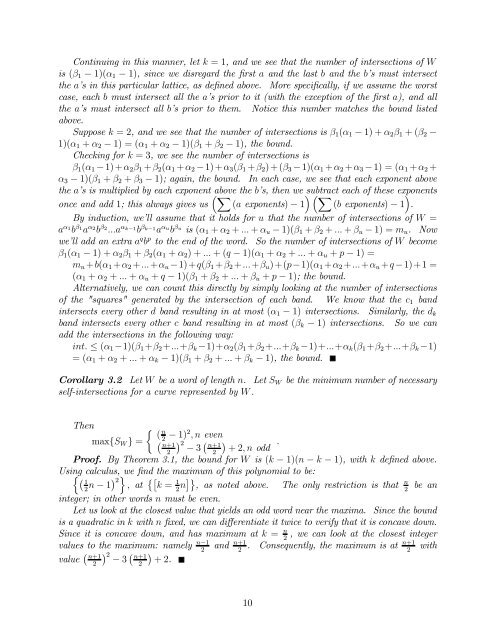The Maximal Number of Transverse Self-Intersections of Geodesics ...
The Maximal Number of Transverse Self-Intersections of Geodesics ...
The Maximal Number of Transverse Self-Intersections of Geodesics ...
You also want an ePaper? Increase the reach of your titles
YUMPU automatically turns print PDFs into web optimized ePapers that Google loves.
Continuing in this manner, let k =1, and we see that the number <strong>of</strong> intersections <strong>of</strong> W<br />
is (β 1 − 1)(α 1 − 1), since we disregard the first a and the last b and the b’s must intersect<br />
the a’s in this particular lattice, as defined above. More specifically, if we assume the worst<br />
case, each b must intersect all the a’s prior to it (with the exception <strong>of</strong> the first a), and all<br />
the a’s must intersect all b’s prior to them. Notice this number matches the bound listed<br />
above.<br />
Suppose k =2, and we see that the number <strong>of</strong> intersections is β 1 (α 1 − 1) + α 2 β 1 +(β 2 −<br />
1)(α 1 + α 2 − 1) = (α 1 + α 2 − 1)(β 1 + β 2 − 1), thebound.<br />
Checking for k =3, we see the number <strong>of</strong> intersections is<br />
β 1 (α 1 − 1) + α 2 β 1 +β 2 (α 1 +α 2 −1) + α 3 (β 1 +β 2 )+(β 3 − 1)(α 1 + α 2 + α 3 − 1) = (α 1 + α 2 +<br />
α 3 − 1)(β 1 + β 2 + β 3 − 1); again, the bound. In each case, we see that each exponent above<br />
the a’s is multiplied by each exponent ³X<br />
above the b’s, then we subtract each <strong>of</strong> these exponents<br />
once and add 1; thisalwaysgivesus (a exponents) − 1´³X<br />
(b exponents) − 1´<br />
.<br />
By induction, we’ll assume that it holds for u that the number <strong>of</strong> intersections <strong>of</strong> W =<br />
a α 1<br />
b β 1<br />
a α 2<br />
b β 2<br />
...a α k−1 b<br />
β k−1a α u<br />
b β u<br />
is (α 1 + α 2 + ... + α u − 1)(β 1 + β 2 + ... + β u − 1) = m u . Now<br />
we’ll add an extra a q b p to the end <strong>of</strong> the word. So the number <strong>of</strong> intersections <strong>of</strong> W become<br />
β 1 (α 1 − 1) + α 2 β 1 + β 2 (α 1 + α 2 )+... +(q − 1)(α 1 + α 2 + ... + α u + p − 1) =<br />
m u +b(α 1 +α 2 +...+α u −1)+q(β 1 +β 2 +...+β u )+(p−1)(α 1 +α 2 +...+α u +q −1)+1 =<br />
(α 1 + α 2 + ... + α u + q − 1)(β 1 + β 2 + ... + β u + p − 1); thebound.<br />
Alternatively, we can count this directly by simply looking at the number <strong>of</strong> intersections<br />
<strong>of</strong> the "squares" generated by the intersection <strong>of</strong> each band. We know that the c 1 band<br />
intersects every other d band resulting in at most (α 1 − 1) intersections. Similarly, the d k<br />
band intersects every other c band resulting in at most (β k − 1) intersections. So we can<br />
add the intersections in the following way:<br />
int. ≤ (α 1 −1)(β 1 +β 2 +...+β k −1)+α 2 (β 1 +β 2 +...+β k −1)+...+α k (β 1 +β 2 +...+β k −1)<br />
=(α 1 + α 2 + ... + α k − 1)(β 1 + β 2 + ... + β k − 1), thebound.<br />
Corollary 3.2 Let W beaword<strong>of</strong>lengthn. Let S W be the minimum number <strong>of</strong> necessary<br />
self-intersections for a curve represented by W .<br />
<strong>The</strong>n<br />
½ (<br />
n<br />
2<br />
max{S W } =<br />
− 1)2 ,n even<br />
¡ n+1<br />
¢ 2<br />
− 3 ¡ ¢<br />
n+1<br />
.<br />
2<br />
2 +2,n odd<br />
Pro<strong>of</strong>. By <strong>The</strong>orem 3.1, the bound for W is (k − 1)(n − k − 1), withk defined above.<br />
Using n calculus, we find the maximum <strong>of</strong> this polynomial to be:<br />
¡ o 1 n − 1¢ 2<br />
, at ©£ k = 1n¤ª , as noted above. <strong>The</strong> only restriction is that n be an<br />
2 2 2<br />
integer; in other words n must be even.<br />
Let us look at the closest value that yields an odd word near the maxima. Since the bound<br />
is a quadratic in k with n fixed, we can differentiate it twice to verify that it is concave down.<br />
Since it is concave down, and has maximum at k = n , we can look at the closest integer<br />
2<br />
values to the maximum: namely n−1 and n+1<br />
n+1<br />
. Consequently, the maximum is at with<br />
2 2 2<br />
value ¡ ¢<br />
n+1 2<br />
− 3 ¡ n+1<br />
2<br />
2<br />
¢<br />
+2.<br />
10

















